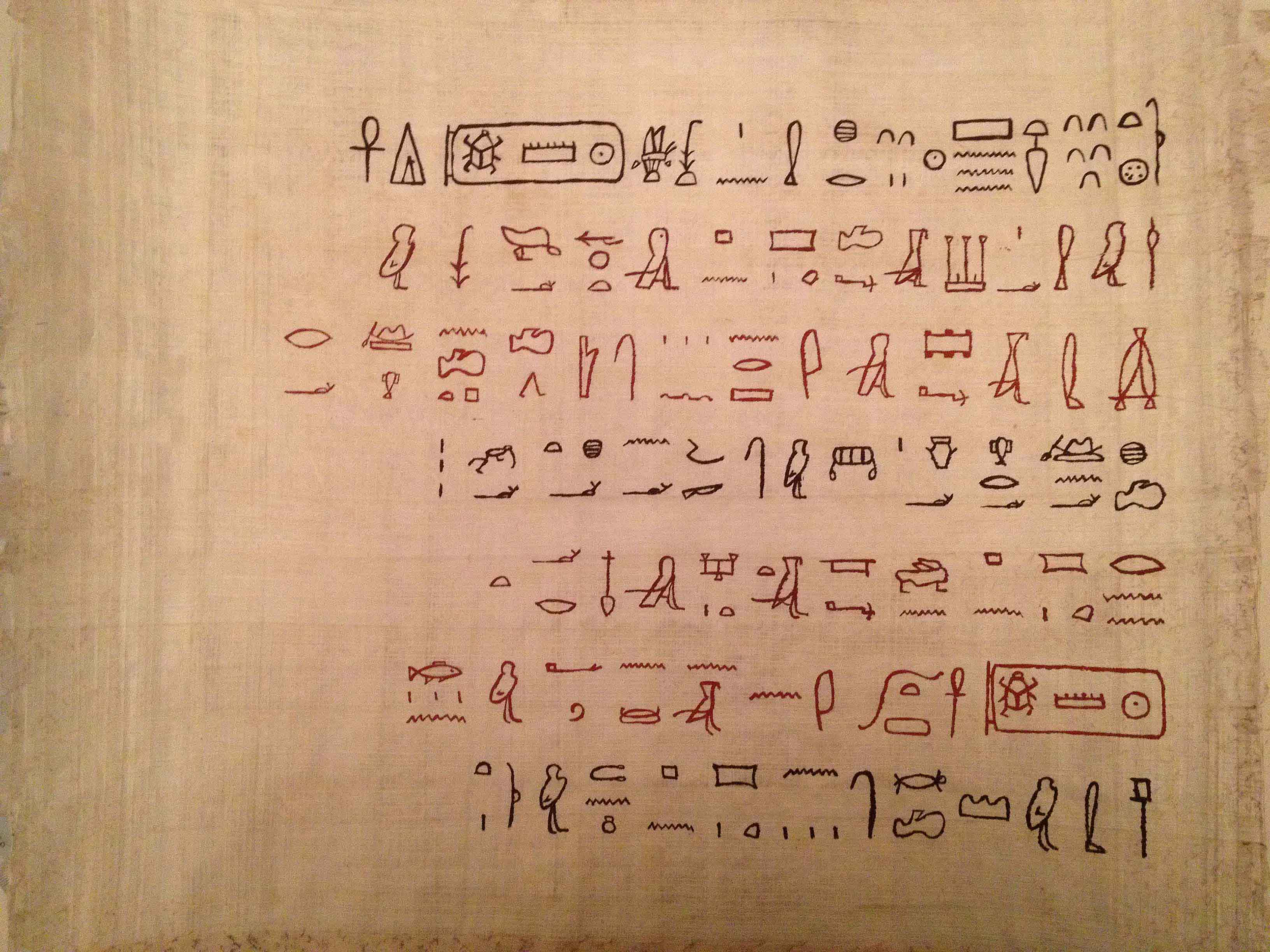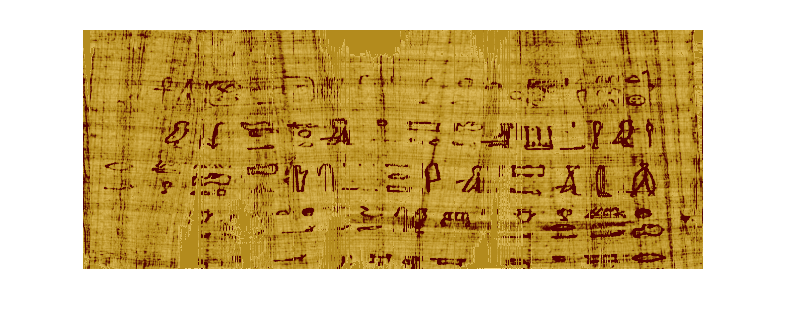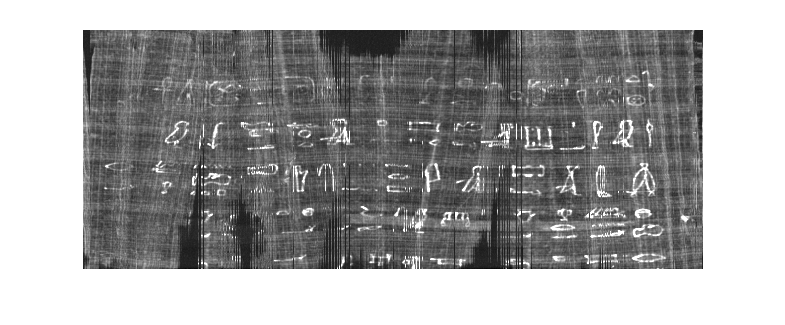Abstract
Recently many efforts to perform virtual restoration of ar
chaeological papyri have been proposed. Papyrus degrada
tion is often very hard so that physical unrolling is sometime
absolutely impossible. In this paper, a new virtual restoration
methodology based on software manipulation of X-ray tomo
graphic images is described. A realistic model, obtained by
painting a hieroglyph inscription on a papyrus substrate made
by the ancient method and using pigments compatible with
the Egyptian use, was made for the X-ray investigation. The
259 slices obtained using a tomography were elaborated with
original software in order to obtain a virtual result that is quite
similar to the hypothetical unrolled sheet. You can Read the complete publication on the journal Applied Physics A here
1. Introduction
Image processing techniques have been successfully applied
in many fields related to Cultural Heritage and can
be also exploited in virtual restoration and preservation of
ancient artifacts like parchments or papyri as part of the
'Archeomatica Project'.
Parchment and papyrus are among the oldest media for
storing text and images. Examples of typical use are related
to the classical period of Egyptian civilization, where they
were used to record historical events, business transactions or
even trivial events (Fig. 6(a)). Indeed, during the excavation
of archaeological sites are often found many ancient artifacts
of this type, however it is not always possible to physically
open the scrolls and read their contents (Fig. 2(b)). This hap
pens for various reasons, such as the parchment may be too
fragile and opening it would risk to introduce tears or creases,
it could be now totally stuck or even afflicted by parasites and
worms that have destroyed the paper. The common practice
is to manually carefully remove one by one each layer of pa
pyrus and recompose this kind of puzzle over a flat plane.
This is an invasive practice and it is not more allowed by the
recent trend of the restoration theory.
Therefore, it is necessary to investigate new techniques
for analyzing the content of parchments and papyri scrolls
without the need to physically unroll them: such technique
is called Virtual Unrolling. To perform virtual unrolling, in
this work we present a technique based upon the use of X-
ray tomographic images. Using a GE Optima 660 device
for computed tomographies (CT), various 'slices' of a realis
tic papyrus have been acquired. Each slice appears as spiral
(Figs. 4(a) and 5(a)). Moreover, it is particularly interesting
to note that when there are text or images in some area of the
papyrus, then the corresponding spirals represented in vari
ous slices contain areas that react more to X-rays, so they are
highlighted with respect to the rest of the sheet. In order to
make our study-case realistic, we realized a papyrus substrate
made by the original method described by Plinius the Elder
and we painted a hieroglyph inscription of Thutmosis III us
ing pigments and binders compatible with the Egyptian use
(ochres with natural glue).
Subsequently, after CT acquisition of the papyrus, we
have developed a software to process the slices acquired. In
this work, we have implemented an automatic virtual un
rolling method. Main aim of this automated procedure is to
identify the path that should be followed to completely unroll
papyrus. Moreover, we have also treated particular difficult
cases, such as interrupted path or multiple path. Finally,
once paths have been computed for (almost) all slices, then
it is possible to properly exploit 3D volumetric data acquired
using CT for virtual unrolling.
The rest of the paper is organized as follows: Section 2
contains references to related works and state-of-the-art. In
Section 3 we report some useful technical specifications about
device used for CT acquisition; the proposed algorithm for
virtually unrolling is presented in Section 4. Some experi
mental settings and results are shown in Section 5. Finally,
we report conclusions about our work in Section 6.
2. Related Works
Physically unrolling could be problematic, in particular when
scrolls are very fragile. For instance, in the 1980s 'Oslo
method' was applied in an attempt to unroll two Hercula
neum scrolls, but it results in partial destruction of them, and
definitely in an irreversible loss for cultural heritage.
For this reason, starting from that event all further attempts to
physically unrolling papyruses or parchments had been aban
doned in favor of digital techniques that could analyze scrolls
without the need of physically open them.
Some works stressed the possibility to use X-ray com
puted tomography (CT) to inner analysis of rolled parchments
and papyruses. In particular, archaeological site of
Hercolanum is rich of carbonized parchments impossible to
unscroll, so many groups have focused their efforts in analy
sis of artifacts coming from this site.
More recent works, that can use better CT devices with
respect on works of some decades ago, continue to afford the
issue of virtually unrolling. Furthermore, in all of
them the acquired CT slices could even present spirals almost
well-spaced, where layers are quite distinguishable between
each others, or totally ill-spaced. In the first case, the prob
lem of overlapping sheet could be solved in practical way; for
instance, in authors applied an algorithm of Graph Cut
for this purpose and used a 3D scanned version of papyrus.
Besides, in the second one, the problem of entire parchment
virtually unscrolling could be too complex, but some small
parts of the sheet can be restored anyway; for example, in
authors shown how problematic could be an ill-spaced spiral
when ink has low contrast; they had selected some regions of
the spiral and manually made them well-spaced; finally, they
performed virtually unscrolling just on it.
In this work, we present a novel automated method to
solve virtual unrolling issue. Despite the aforementioned ap
proaches, our algorithm does not use 3D scans, but images
only. Moreover, the path is automatically detected, in spite of
manual approaches cited. Finally a clever using of morpho
logical operator is made, so a simple and efficient algorithm is
guaranteed. This solution also fit the problem of interrupted
paths


3. X-RAY Computed Tomography
Computed Tomography (CT) is a technique that using X-ray
produces tomographic images, or simply 'slice', of an object
or even a person. It is applied in medical contests to view the
inner part of patient body. We used the GE Optima 660 device
for CT acquisition of our study-case papyrus Fig. 2. Accord-
ing to technical specifications, minimal isotropic spatial reso
lution of this device is 0.35mm and it can provide until to 128
distinct projection measurements per rotation. Moreover, ap
plication software provided with GE Optima 660 has an utility
function that, through a path selected point-by-point by user,can perform a roughly virtual unroll of papyrus. However,
this is an error-prone procedure, that could introduce artifacts
and missing parts in the virtually unrolled version of the pa
pyrus (Fig.1).
4. Proposed Method
The images we get from XCT represent the papyrus section,
so these look like as spirals. For each papyrus section, the
start and final point of the spiral should be identify in order to
build an array of ordered pixel. Unfortunately, it is not easy
to sort the points which compose the slice, because of the
low resolution and some papyrus overlapping sheet. For this
reason, we decided to use a single section profile and follow
it for all the slices, assuming that there are few differences
between a couple of different sections.
The first step of the proposed algorithm is the selection of
a good slice using the following criteria:
1) Low number of overlapping sheets into the slice. In the
best case there is no overlaps;
2) The spiral path should be almost entirely detected througha raw segmentation.

4.1 Step 1: Slice selection
To satisfy first criteria the skeleton branch-points are detected
using morphological operator. Specifically, the follow
ing image segmentation is performed:
1) Gamma transformation with y = 2 and contrast stretching
in order to highlighted the papyrus section;
2) Otsu thresholding to get a raw segmentation;
3) Morphological skeletonization to detect a first raw path;
4) Morphological branch-points detection to identify over
laps;
If a sheet overlap exists, then it produces a branch-point
into the skeleton. Of course, not all the branch-points indicate
a sheet overlap, since they could be image artifacts or papyrus
creases. However we choose the slices with the lowest num
ber of branch-points in order to minimize the probability that
an overlap occurs.
To satisfy the second criteria the number of skeleton
points is counted for each papyrus slice, then the average
number is computed. Finally, a slice with a number of skele
ton points nearest to the average value is chosen. Skeletons
with too few points describe slices poorly definite, while
skeletons with too many points could be affected by noise.
4.2. Step 2: Slice reconstruction
Once a good slice is detected, the spiral must be rebuilt.
First, we apply the preprocessing described above. Then the
branch-points and their 3 x 3 neighbourhood are removed
from the skeleton in order to disconnect the ramifications.
Now the end-points are detected using the proper morpholog
ical operator. The end-points are pixels which locate a break
on the skeleton.
So the user selects the start point and the final point of the
spiral. This is the unique user interaction of the algorithm.
Starting from the initial point, the 3 × 3 neighbourhood is
take into account for each pixel and the following step are
performed:
1) If into 3 x 3 neighbourhood there is a not visited skeleton
point, which is not an end-point, then it is added to an
array of visited point. You move on this new point and
the algorithm continues.
2) If into 3 x 3 neighbourhood there is a not visited skele
ton point, which is an end-point, then a break has been
reached. To rebuild the missing path, the intensity grey
value of the contrast stretched image is used (e.g., Fig.
4(b) and Fig. 5(b)). Specifically, the pixel of maxinum
value is taken. However the 3 x 3 neighbourhood is
weighted through a probability mask. There is a mask for
each possible direction in 3 x 3 neighbourhood, so there are eight masks. These eight masks has built using a sam
pled derivative of gaussian filters and weighs more the
pixel along the last direction of movement. When a new
end-points is reached two skeleton parts are reconnected.
The algorithm ends when the final point is reached.
4.3. Step 3: Unrolling
The last step is the papyrus virtual unrolling. For each slice
we select the sequence of pixel whose coordinates are stored
in the vector of visited points. For each coordinate the pixels
of maximum intensity along the direction of the gradient is
chosen. Indeed sheet and text or image have an higher inten
sity than background. In this way we obtain a string of pixels
for each slice (e.g., in Fig. 3). By stacking all this string we
get the image of the papyrus rolled out.
5. Experimental Results
To test the proposed approach a set of 259 slices of a single
rolled papyrus has been used. The original size of the slice
image is 512 x 512, but a crop to 175 x 175 has been per
formed in order to focus on the papyrus spiral profile. Using
the aforementioned criteria, a good slice has been automati
cally selected: a section with 0 branch-points and a number
of skeleton points near to average number. In Fig. 4 you can
see the processing step for the chosen slice.
However, to show the overlap problem a bad slice exam
ple has been reported in Fig. 5. In in Fig. 5(d) the branch-
points pixel locate on the overlapping area can be seen. Of
course, the image in Fig. 4(d) is totally black because there is
no branch-point detected.
In Fig. 4(f) the reconstructed path after the step 2 is
shown. Finally, using the array of visited points each of 259
spirals is unrolled. For each coordinate in the array, we take
into account 25 pixel (according to resolution) along the gra
dient direction and choose the maximum value. This strategy
is motivated by the fact that there is some slight difference
between the prototype path and every other spiral path.





Fig. 6 . (a) The original study-case unrolled papyrus; (b) A
virtual unrolled version of the papyrus through the proposed
algorithm; (c) A false color version of the image (b).
6. Conclusion
In this paper, we propose a method for virtual unrolling of
papyrus. This work is motivated by the criticality of a physi
cal papyrus unrolling, because of the high risk to damage the
cultural heritage. To solve this problem a X-Ray Computed
Tomography device has been involved in order to scan the
cross-section of the artifact. The input of the proposed algo
rithm is a set of slices from a single CT acquisition. Through
mathematical morphology the spiral path of a good slice is rebuilt, in order to be used as prototype path for every other
slices. The experimental results show that this approach is
valid, since many symbols of the original papyrus become
visible after the virtual unrolling. In the future works we con
sider to solve the overlapping sheets issue for each slice, so
to use more than a single path. In this way a better and more
accurate result could be obtained.
